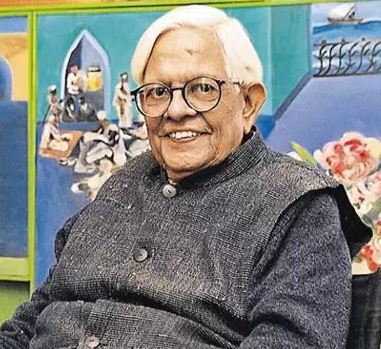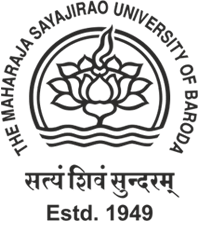
About Me:
-
Name:
Shri Bhupen Khakkar
-
Category:
Cinema and Arts
-
Award:
Padma Shri (1984).
-
Area:
Leading Artist In Indian Contemporary Art.
Details:
Education: B.A., With Economics and Political Sciences as his Special Subjects, Bachelor Of Commerce from Sydenham College Of Commerce and Economics and Qualified as a Chartered Accountant
Biography: Khakhar was a Self-Trained Artist, and Started his Career as a Painter Relatively Late in his Life. his works were Figurative in Nature, Concerned with the human body and its identity. an openly gay Artist, The Problem Of Gender Definitions and Gender identity were major themes of his work. his Paintings Often Contained References to Indian Mythology and Mythological Themes.
Bhupen Khakhar was born in bombay and Spent his Boyhood in the area Called Khetwadi with his Parents and three Siblings. He was the Youngest Of Four Children, and his Father, Parmanand, was an Engineer and was an External Examiner at VJTI Matunga, Mumbai. Parmanand Drank Heavily and Died When Bhupen Was Only Four Years Old. His Mother Mahalaxmi was a Housewife, and She Soon Invested all Of Her Hopes In Her Youngest Child.
The Khakhars were Originally artisans who Came From The Portuguese Colony Of Diu. at Home They Spoke Gujarati, Marathi and Hindi, But not Much English. Bhupen was The First Of His Family to attend The University Of Bombay, Where. Khakhar Worked as an Accountant For many Years Partnering with Bharat Parikh & Associates in Baroda Gujarat India., Pursuing his Artistic Inclinations in his free Time. He became wll Versed in Hindu Mythology and Literature, and well Informed about The Visual Arts.
In 1958, Khakhar met The Young Gujarati Poet and Painter Ghulam Mohammed Sheikh, Who Encouraged Khakhar's Latent Interest In Art and Encouraged him to Come to The Newly Founded Faculty Of Fine Arts In Baroda.
Khakhar's Oil Paintings were Often Narrative and Autobiographical. his first Exhibited Works Presented Deities Cut From Popular Prints, Glued Onto Mirrors, Supplemented By Graffiti and Gestural marks. He began to Mount Solo Exhibitions as Early as 1965. Though The Artist had been Largely Self-Taught, His Work Soon Garnered Attention and Critical Praise. by The 1980s, Khakhar was Enjoying Solo Shows in Places as far away as London, Berlin, Amsterdam and Tokyo.
The Artist's Work Celebrated The Day to Day Struggles Of India's Common Man. Khakhar's Early Paintings Depicted Average People, Such as The Barber, The Watch Repairman, and even an Assistant Accountant With Whom He Worked. The Painter Took Special Care to Reproduce The Environments Of Small Indian Shops In These Paintings, and Revealed a Talent For Seeing The Intriguing Within The Mundane. His work has been Compared to that Of David Hockney. He was a Long Standing Personal Friend Of Howard Hodgkin Who Regularly Came to Stay With Him After Meeting in 1975. though he was influenced by the British Pop Movement, Khakhar Understood that western Versions Of Pop Art Would not have the Same Resonance In India.
Khakhar's Often Openly Homosexual Themes Attracted Special Notice. Homosexuality was Something that at The Time Was Rarely Addressed in India. The Artist Explored his Own Homosexuality in Extremely Personal ways, Touching Upon both its Cultural Implications and its amorous and Erotic Manifestations. Khakhar Painted Homosexual Love, Life, and Encounters from a Distinctively Indian Perspective.
In The 1990s, Khakhar Began Experimenting More With Watercolours And Grew Increasingly Confident In Both Expression And Technique. He Found Himself Portrayed As "The Accountant" In Salman Rushdie's Novel The Moor's Last Sigh. Khakhar Returned The Favour By Later Making A Portrait Of The Author That He Called The Moor, And Which Is Now Housed Within The National Portrait Gallery, London. In You Can't Please All (1981; London, Knoedler's) A Life-Size Naked Figure, A Self-Portrait, Watches From A Balcony, As Father, Son And Donkey Enact An Ancient Fable, Winding Through The Townscape In Continuous Narration.
Khakhar Was Honoured With The Prince Claus Award At The Royal Palace Of Amsterdam. Among Other Honours, He Won The Asian Council's Starr Foundation Fellowship, 1986, His Works Can Be Found In The Collections Of The British Museum, The Tate Gallery, London, The Museum Of Modern Art, New York, Among Others.
Books: Bhupen Khakhar, A Retrospective, Timothy Hyman, The National Gallery Of Modern Art And The Fine Art Resource, 2003 Desai, Mahendra; Bhupen Khakhar (1983). A Man Labelled Bhupen Khakhar Branded As Painter. Bombay: Identity People.

